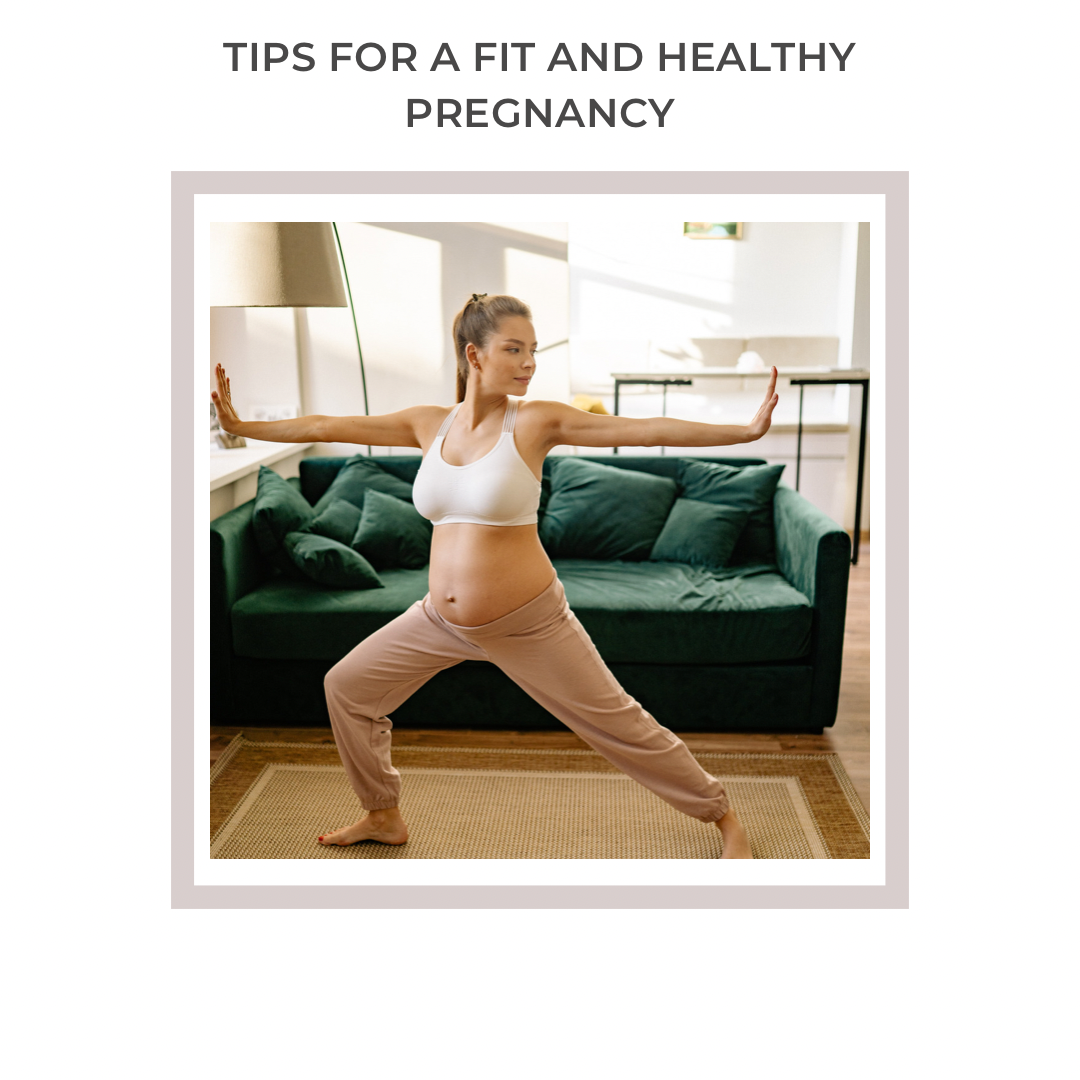Tips for a Fit and Healthy Pregnancy

Article published at: "Be Your Own Collective"
Credit: Sabrina Ovadya-Lenson
TIPS FOR A FIT AND HEALTHY PREGNANCY
1. Movement and Exercise
In the absence of any contraindications it is crucial to keep moving during pregnancy. This could be in the form of lower impact exercises, walking, pregnancy Pilates, pregnancy yoga, swimming and so on.
Being mobile during pregnancy is important to keepthe body healthy, to prepare it for birth and to makethe process of rebounding easier post-partum. Inaddition to physical benefits, exercise promotesemotional health. Further, carrying a baby can at times be a tiring process and exercise will ultimately energise the body.
Especially during the last trimester ‘swimming’ is a lovely and gentle way of exercise. With the lack of gravity in water the joints and the back can take a much-needed break.
When it comes to prenatal exercises, in general it is safe to follow similar but adjusted routines as before pregnancy but it is best to avoid risky exercises such as ice skating, contact sports and so on.
2. Warm up and Cool down
One of the most important tips in regards to exercise during pregnancy is to ensure to warm up and cool down. This is important for anyone before and after exercise but even more so for pregnant ladies as the body will be more prone to injuries due to hormonal changes that relax the joints as well as other physiological changes in the body. To prevent injuries always remember to warm up and cool down!
3. Eat a well-balanced diet
The “eating for two” is actually a debunked myth, a pregnant woman only needs about 300 more calories daily in the first two trimesters, and then about 500 calories on the last trimester. Having said that pregnancy is not the time to diet and restrict oneself, it is simply the time to eat a healthy, balanced and varied diet.
During pregnancy what you eat also feeds your baby so it’s even more important to eat an array of different natural foods so the body and the baby can both receive all the necessary nutrients.
Eating lots of vegetables and fruit in addition to protein, whole grains and healthy fats, having the meals in smaller portions but often will help feeling full whilst getting the necessary nutrients in.
4. Keep hydrated
Drinking plenty of water is crucial as the body needs more water than normal during pregnancy. The reasons for this include the increased blood volume and the amniotic fluid which is mostly made up of water. It is best to avoid sugary or caffeinated drinks. Carrying a water bottle and preparing healthy green juices in advance may help with keeping hydrated.

5. Set a sleep and relaxation routine
Getting good quality sleep is essential. As exciting as it is, pregnancy can also be a time of worries. The hormonal changes further can lead to an emotional roller coaster. Good sleep, meditation and breath work can all help with relaxation. Also, remember that the body will need to recharge before the baby is born!
Sleeping sometimes can be difficult due to all the physical changes and the growing bump; it may help to invest in a pregnancy pillow or to prop up oneself accordingly to achieve a more comfortable sleeping position.
Another tip is to create a relaxation routine before bed time, whether it is a candle, reading a book or using a sleep mask during sleep.
6. Listen to your body
Relax and sleep when you need to, move your body when you feel energised and often. Eat when you feel hungry. Don’t put unnecessary strain on the body or the mind. If something doesn’t feel right, do not push yourself and speak to a doctor and midwife when appropriate.
Exercises:
Squats are great for each trimester as long as they are performed with correct form. They are perfect for strengthening the leg and glute muscles to prepare the body to carry the weight of the growing bump.
1st trimester:
Prenatal Yoga or Pilates exercises are effective yet safe during pregnancy. Some women may feel a bit apprehensive especially the first trimester with thehigher risk of miscarriage so the recommendation is to listen to your body and perform gentle exercises as long as you are cleared by the doctor.
1. Pelvic tilts: It is best to learn to activate and release the pelvic muscles sooner rather than later in the pregnancy. This exercise can be performed standing, sitting or on hands and knees.
- Stand tall in a neutral alignment. Take a breath in to prepare, tuck the pelvis under as you exhale. This means the hip bones travel up towards the belly button. Release as you inhale. It is also important to change the breathing and learn about the release (this is crucial for natural birth!).
2. Gentle abdominal exercises: We certainly want a strong core during and after pregnancy but the abdominal exercises especially as the pregnancy progresses should be performed with caution and only the ones that are appropriate as to not break the abdominal muscles (Diastasis recti). The following exercise can be done throughout with some adjustments each trimester.
- Sit on the floor and bend the legs slightly. Bring the arms in front of the chest in the air. Tilt the pelvis tucking it under and roll back the spine lightly with the exhale. Bring the spine back with the inhale. The same exercise can be performed with hands on the knees to reduce the load on the belly. During the last trimester the roll back can be skipped.
2nd trimester:
1. Arm exercises with small weights are excellent during this trimester. They can include working the biceps, triceps and shoulders. It is important to ensure that the weight is not felt on the abdominalsif you are lifting the arms above the head. All these exercises can be performed standing or seated. Seated versions with the back against a wall or chair will provide more support and may be more accessible as the bump grows.
2. Glute exercises on hands and knees are fantastic to strengthen those areas which makes it easier to carry the weight of the growing baby.
- Once you have good alignment, bend one leg and press it up towards the ceiling in a bent position 10 times. Add 10 small pulses towards the ceiling.
- Bring the leg in towards the chest and extend it behind 10 times. Repeat on the other side. If it feels good, perform one more set.
3rd trimester:
1. Swimming: Swimming is a very gentle form of exercise and feels great especially during the last trimester as it gives the back a break from carrying the load. It mobilises shoulder and hip joints.
2. Cat cows on hands and knees: This exercise is gentle and feels fantastic for the spine which takes a big load during pregnancy. Usually this last trimester is accompanied by lower back pains. The upper back also tends to get stiff so this exercise will help mobilise the whole spine. It also feels lovely as the bump can simply hang and the weight is not felt on the joints.
3. Side lying leg exercises: Side lying exercises are still accessible during these last months. Sometimes it feels more comfortable to put a towel under the bump. Support your head with the bottom hand. Try to keep a long spine and the top shoulder away from the ear. Bottom leg is bent on the floor. Make sure to do both sides.
- Lift and lower your top leg 10 times.
- Draw small circles with the top leg 10 times and reverse.
4. Chest openers and shoulder mobility: These are feel-good mobility exercises. Sit on the floor in a comfortable position keeping the spine long.
- With your arms draw circles in the air 10 times one direction and 10 times reversing it.
- Flyes: Now hold the arms in front as of you are holding a beach ball, with a small bend in the elbows. Inhale to open the arms and exhale to bring them back.
Always listen to your body and more so, during pregnancy!


